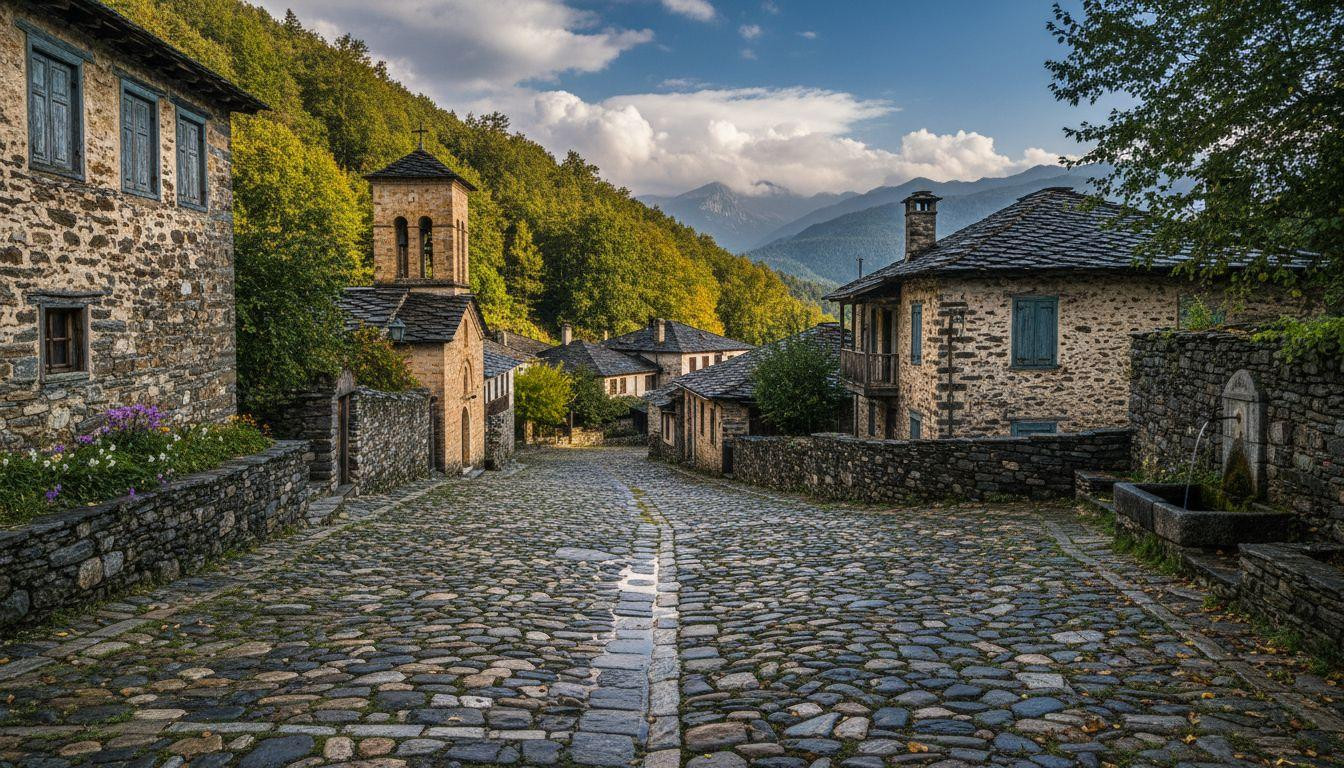Stone pathways wind through Vitsa where pack animals walked before roads reached this 200 resident mountain village. At dawn, fog laces the cobbled Skala routes that connect grey limestone houses across terraced slopes. The sound of footsteps on ancient stone echoes exactly as it did in 1868.
Morning light filters through forest canopy onto pathways designed for donkeys carrying cargo. These narrow routes, carved into Pindus mountainsides, preserved a village frozen in pre-automotive time. When modern Greece built highways, Vitsa remained accessible only by foot.
The Skala network that defied roads
Vitsa’s stone pathways were engineered in 1868 with precise 4-5 foot widths. Pack animals navigated tight mountain turns while carrying goods between Zagori’s 46 stone villages. The Skala network spans over 750 miles across the broader region.
Cobblestones follow herringbone patterns for drainage and traction. Turns feature banked outer edges that prevented cargo loads from shifting during steep climbs. These engineering details distinguish Vitsa’s pathways from simple hiking trails.
The village maintained 65% of its original pathway network while neighboring settlements sacrificed historic routes for vehicle access. Eight stone villages across Epirus preserve similar limestone architecture, but none match Vitsa’s pathway preservation.
A village outside road time
Stone architecture that survived isolation
Grey Zagori limestone houses climb terraced slopes with dark slate roofs. Traditional construction uses dry-stone techniques without mortar, allowing walls to flex during freeze-thaw cycles. Buildings reach 2-3 stories with 8-12 meter widths.
The Church of Agios Nikolaos anchors the village center with its bell tower visible from most pathways. Stone masonry families maintain building techniques passed through generations. UNESCO protection requires all repairs to match historical materials and methods.
The Bridge of Misios hidden in forest
A 15-minute walk via Skala pathways leads to the 1748 Bridge of Misios. This single-arched Ottoman bridge spans 8 meters above seasonal streams. Dense forest conceals the approach until visitors emerge at the stone crossing.
The bridge connects Vitsa with Koukouli and Kipi villages along ancient trade routes. Spring snowmelt occasionally floods the river crossing, but the stone arch remains accessible year-round. Moss growth on surfaces indicates the humid microclimate beneath forest canopy.
Walking the ancient routes
Hiking the Skala today
Village pathways remain the primary route between 65% of residential properties. Parking areas sit 350 meters from the village center, forcing visitors to experience pre-automotive movement. The Kokkori Bridge lies 3.5 kilometers away via historic routes.
September and October offer ideal hiking conditions with temperatures between 50-68°F. Autumn foliage peaks during the third week of October when maple, oak, and beech trees create dramatic color displays. Fog patterns in November enhance the mystical atmosphere of morning walks.
Village life at 3,117 feet elevation
The Epekeina Hora cultural space hosts stone masonry workshops for $40 on Saturdays. Traditional music evenings cost $11 on Thursdays from 7-9 PM. These programs operate April 15 through October 31 each year.
Seven tavernas operate year-round serving traditional Zagori pies for $15-25. Full meals including local lamb dishes and regional wines range from $31-42. Mountain villages like Lewisburg share similar rhythms of unhurried daily life.
Mountain silence and stone
Church bells mark morning hours while gentle water sounds flow from mountain springs. The absence of traffic creates a sound environment dominated by forest breezes and birdsong. Night skies reveal stars invisible in road-accessible villages.
Population swells to 450-500 residents during summer months when diaspora families return. Winter drops the count to 150 permanent residents who maintain traditional mountain rhythms. This seasonal fluctuation preserves authentic village character without tourist infrastructure pressure.
Accommodation rates average $95 per night, which runs 23% lower than comparable Monodendri lodging. Medieval stone villages across Europe rarely maintain such accessible pricing alongside architectural preservation.
Your questions about Vitsa answered
How do you reach Vitsa without walking extensively?
Modern roads connect Vitsa to Ioannina in 1 hour covering 31 miles. Four daily buses depart at 7:30 AM, 10:00 AM, 1:00 PM, and 4:30 PM for $6 one-way. The journey takes 1 hour 15 minutes. Taxis from Ioannina cost $61-72 each way.
When is the best time to visit for pathway hiking?
May through October provides optimal conditions with temperatures from 59-86°F. September and October see 60-65% fewer visitors than peak summer months. November offers atmospheric fog effects but temperatures drop to 41-54°F with minimal tourist services.
How does Vitsa compare to other Zagori villages?
Vitsa receives 35,000 annual visitors compared to 52,000 in Monodendri and 48,000 in Papigo. The village maintains stronger authentic character with fewer commercial accommodations. Monodendri offers easier Vikos Gorge access but higher crowds and 23% higher lodging costs.
Dawn breaks at 7:18 AM on late November mornings as fog begins lifting from stone pathways. The soft golden light illuminates grey limestone facades while distant goat bells echo through mountain valleys. This is mountain time, measured in footsteps rather than speed.
